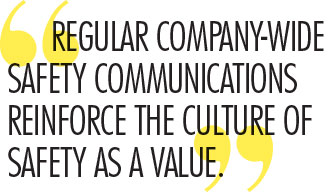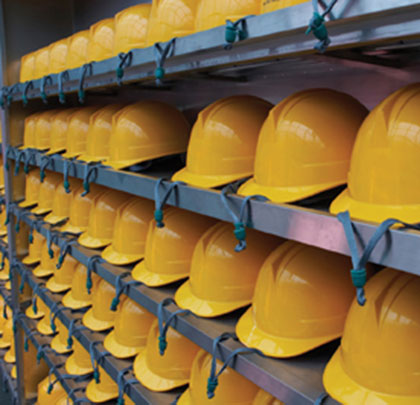Management commitment is critical to improving the jobsite safety climate. Managers that “talk the talk” but do not “walk the talk” are poor safety role models and will have difficulty establishing the trust needed for all to participate in keeping everyone on the jobsite injury-free. It’s the job of management to ensure that safety expectations are clearly defined in policies, procedures, and guidelines, and communicated across the company. There should be adequate resources are available to effectively implement safety activities, making safety is a top agenda item at all meetings. And it’s vital that all workers receive sufficient safety training and have proper personal protective equipment (PPE). Here are other ways to establish a safety culture.
ALIGNING AND INTEGRATING SAFETY AS A VALUE
Safety is integrated throughout an organization and aligned with productivity and other organizational priorities. Organizational members and subcontractors see safety as a core company value rather than an additional burden or diversion from “normal” operations. Regular company-wide safety communications reinforce the culture of safety as a value (e.g., newsletters, alerts, leadership messages, safety topics, etc.). Employees at all levels are recognized for participation in safety activities.
ENSURING ACCOUNTABILITY AT ALL LEVELS
Policies and procedures that specify roles and responsibilities are needed to ensure everyone involved in a construction project is held accountable for safety: owners, management, safety personnel, supervisors, and workers. Enforcement and fairness are critical for achieving a strong jobsite safety climate. It’s important that the system is perceived as fair so enforcement of safety policies and procedures remains consistent.
IMPROVING SITE SAFETY LEADERSHIP
Front-line supervisors are the linchpin of any safety program. They have the power to address hazards before anyone gets hurt. Their ability to lead and communicate with workers about safety issues is critical to achieving a strong safety climate. Consider the following:
- Safety is included in the strategic planning process.
- Safety roles and responsibilities are clearly defined at all levels of the organization.
- People at all levels are held accountable for their safety responsibilities.
- Supervisors lead by example.
- Senior leaders are visible on safety issues.
- Leadership promotes a learning environment.
- Supervisors are provided with, and required to take training in safety communication, motivation, and preplanning.
EMPOWERING AND INVOLVING WORKERS
Involving workers in safety-related planning and decision making and empowering them to speak up when they identify hazards helps to bridge the communication gap between workers and management, and creates the positive safety climate integral to getting the job done safely. Site orientations empower workers to actively participate in safety implementation. Have a joint worker-management safety committee and involve workers in job hazard analyses. Conduct joint walk-arounds regularly and focus on addressing specific problems raised by workers and others.
IMPROVING COMMUNICATION
Organizational communication occurs through formal and informal mechanisms and can be transmitted in the form of words and actions. Poor communication about safety issues can significantly impact an organization’s ability to take proactive and preventable actions to address concerns before an incident occurs.

TRAINING AT ALL LEVELS
All organization members need to know and understand where they fit into a project’s safety climate. The best way to ensure this happens is to provide on-going, effective training tailored to the specific roles and responsibilities of individuals at each level of the organization. Ensure the following:
- Safety training is provided at all levels of the company, and is ongoing.
- Company requires supervisors to have STS certification.
- Safety leadership training is available for supervisors and foremen.
- Empowerment and peer training is provided to workers.
- Prevention through design training is provided to in-house architects and engineers.
- Joint safety committee training is given to all participants.
- All field personnel help to identify training needs, and develop materials.
ENCOURAGING OWNER/CLIENT INVOLVEMENT
Owners are uniquely positioned to promote safety as an organizational value from the top down. They have the authority to develop and issue company policies, shape bidding practices, and ultimately approve budgets, all of which, if done with safety in mind, can drive a strong project safety climate, as well as excellent safety performance. ■
For More Information:
Much of the information presented was provided by stakeholders who participated in a CPWR-sponsored Safety Culture/Climate in Construction Workshop held June 2013. This information was made possible by cooperative agreement number U60-OH009762 to the CPWR—The Center for Construction Research and Training from the National Institute for Occupational Safety and Health (NIOSH). If you have feedback you would like to share, contact Dr. Linda M. Goldenhar at lgoldenhar@cpwr.com.
_________________________________________________________________________
Modern Contractor Solutions, March 2015
Did you enjoy this article?
Subscribe to the FREE Digital Edition of Modern Contractor Solutions magazine.



